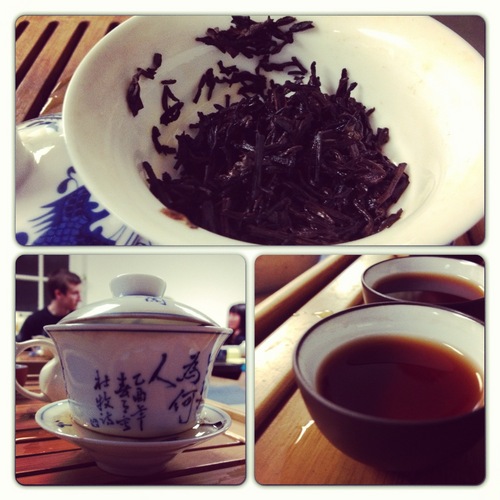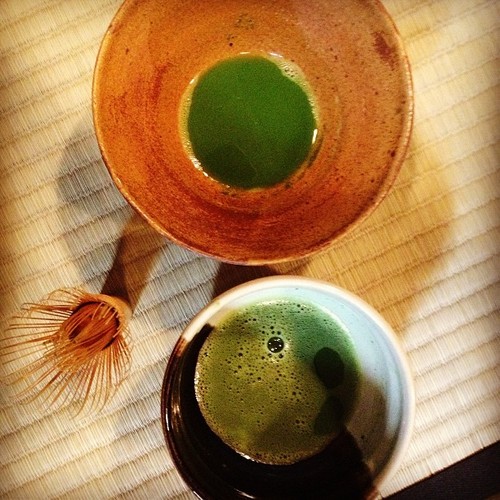Our third day is Bali was also unfortunately our last day, and we made it worthwhile! We made our way back to Ubud to do the things we didn’t get around to when we were there two days prior.
Temples & Cultural Dance
After breakfast at the villa, I left with the early group at 8am and headed to our first stop at a temple where we saw the cultural Barong Dance. This style of Balinese dance is unique and tells a story through dance, narrating the fight between good and evil. Essentially, it incorporates myth, history, and performance into entertainment.
The show we saw has been adapted over time to perform for mainly visitors, and differs in a few small ways from the true religious-based dances performed at real temple festivals. However, it is still an accurate representation of Balinese cultural dance. It is common to see actors dressed up as animals in these shows, and there is heavy use of costuming and makeup on both males and females. Seeing a cultural dance was one of the things I was most excited for, but unfortunately the show involved very little actually dancing. We were taken by surprise to find out that most of the show was simply actors running around stage acting out daily activities or fights, and strangely enough we continued to learn that the Balinese cultural has a very interesting tradition of including strange sexual actions and innuendoes in shows and artwork. We were all a little caught off guard by this, but nonetheless glad we took the opportunity to see a cultural show.
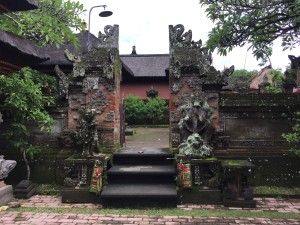
First temple visit of the day
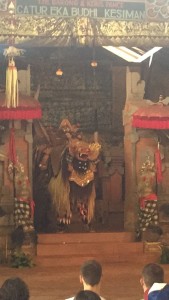
Lion dancing at the opening of the show
Traditional Balinese orchestra playing in the show
Traditional dancers in the cultural show
Our next stop was at the iconic Batuan Temple, located in the middle of a village on a main road from Denpasar to Ubud. In my opinion, this was the most well-preserved and architecturally beautiful temple that we were able to visit. This temple is used by Batuan villagers to worship to the god, during temple festivals which are held twice a year.
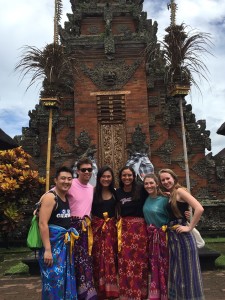
Inside entrance to Batuan Temple
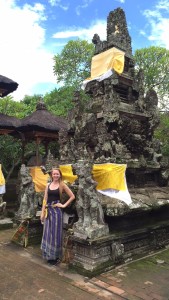
Inside Batuan Temple
Satri Coffee Plantation
Our next stop was suggested by our villa driver, and we were very interested to add it to our itinerary. We visited Satri Coffee Plantation, which grows, processes, and sells many different kinds of coffees, teas, spices, and chocolates. They produce a few different kinds of coffee, but take the most pride in their Luwak coffee, which is alternatively known as “the best coffee in the world” according to the plantation. Essentially the civet cat, commonly referred to as the Kopi Luwak ingests coffee beans as part of its diet, their waste is collected, and whole coffee beans are cleaned from the waste then processed into coffee. This coffee actually is well known around the world, selling for upwards of $30 a cup in places like New York City and London. Supposedly, the Luwak’s digestive system gives the coffee a unique rich aroma and smooth, rounded flavor.

Walking path through the coffee plantation
The plantation tour guide started by giving us a personalized tour of the property, which was much smaller than expected. I am assuming they have production areas outside, and the “plantation” was mostly for visitation, tasting, and sale purposes. The entry area housed multiple buildings filled with artwork and beautiful architecture, where we were told numerous weddings take place. Private rooms are also available to rent out for honeymoons.
We walked through the pathway learning about what all they grew, seeing plants like ginseng, vanilla, cocoa, ginger, and chile. Towards the back of the property we were given a brief lesson on how the coffee is processed, as shown in the photo below. The workers hand peel every single coffee bean, and the entire process is completed by hand, literally ground and browned in a cast-iron kettle with human labor (no wonder it’s expensive!). We were also shown a variety of spices grown on property, and smelling the fresh coffee beans and spices was an amazing experience, so strong scented and delicious!
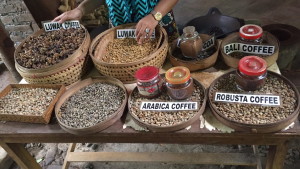
Step by step display process of making coffee
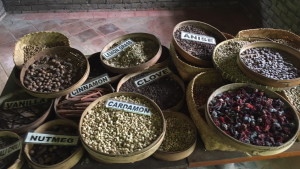
Variety of spices produced on property
We tasted an assortment of teas, coffees, and chocolates, and eventually made our way to the store for a few souvenirs. Watching them make the coffee was one of the most interesting ways I’ve ever seen coffee processed. As you will see in the video below, it looks more like a science experiment!
Making a cup of “the best coffee in the world”
Bebak Teba Sari
Another recommendation by our kind villa driver, we were taken to lunch at a small restaurant called Bebak Teba Sari, with small gazebo’s available with seating right on the water. We enjoyed the food, but enjoyed the atmosphere more. It was lovely having lunch on the water, watching the fish swim beneath us, and being excited about how productive and amazing our day had been so far.

Row of gazebo’s on the water
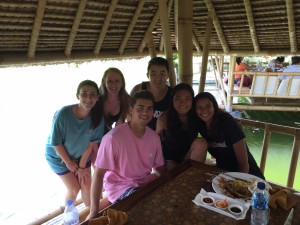
Enjoying lunch on the water
Mandala Suci Wenara Wana
Next we visited the iconic Sacred Monkey Forest, the official name is listed above. The monkey forest is a place where everyone told us we had to visit, and most of us had a fantastic time! I, however, was terrified of the monkeys and ended up visiting a few local shops outside with one of my other friends until everyone else was finished spending time on the property. Essentially, this is a reserve where you can go inside and be among the monkeys. I was not too fond of getting so up close and personal, but it provides a fabulous photo opportunity for those willing to brave it out!
Ubud Markets
Our next stop took us to to the traditional art market in Ubud. This complex is essentially blocks of street artists and vendors selling traditional Balinese crafts (and some touristy items..). We spent about an hour perusing the buildings of endless rows, and most of us used the rest of our spending money to barter for souvenirs to take home with us. I got some traditional Balinese fabric, a sarong, and a few clothing items. Unfortunately we did not have a great deal of time to enjoy the marketplace, and also all of us managed to get lost in the aisles at least once or twice. With phones dying left and right, confusing twisted pathways of all very similar items for sale, our villa driver not being where we planned on meeting at the correct time, and getting split into groups while shopping, and actually getting lost at one point, SOMEHOW we managed to all make it back on the same street corner and back into our van. We checked in with the other group, who had left the villa around lunchtime, and just recently made it the monkey forest, and soon were on our way to our next stop!
Tegallalang Rice Terrace
Our last activity on the agenda for the day was visiting a remarkable rice terrace. If you have ever seen pictures of these incredibly landscaped areas, you will know exactly what I am talking about. While visiting a rice terrace has been on my life bucket list forever, I was unaware that we were going to visit one during our time in Bali. Needless to say, it was a pleasant surprise that probably made it to one of my top moments in Bali!
Terraced rice fields actually cover much of the land across Bali, since much of the diet consists of rice, driving throughout the country you will see many of these production areas. However, most of these are only a level or two, and much smaller than the rice terraces pictured below. The more landscaped ones were created around the 9th century, and were engineered by the Balinese using a natural irrigation system of water flowing down from the mountains. They create step-like landscaping to make use of the natural flow of water, and what results is an incredible artwork of landscaping. However, it is important to make note that rice farming is an incredibly laborious job. While the Tegallalang Rice Terrace is more of a tourist attraction (literally, you have to pay to get in), a true rice terrace is a place where the Balinese work very hard to produce the product that contributes so much to their society and diet. Regardless, visiting the rice terrace was a stop worth making!

Teagallang Rice Terrace
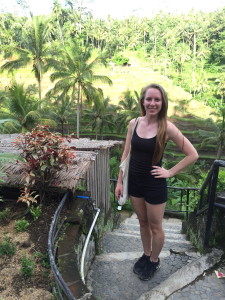
Top of the terrace, at the restaurant lookout point

Panoramic view of the rice terrace
“Love Bali”
With having a red eye flight that evening, we were able to make use of the entire day on Sunday. In fact, since both of my flight were red eye’s, I was able to make use of the entire three days I spent in Bali. After the rice terrace we headed back towards Seminyak and the airport area, stopping for dinner along the way at a restaurant called Three Monkeys Cafe. We ate a quick dinner to stay on time, and headed back to the airport after what seemed like we just arrived. We thanked our driver profusely for everything, took a picture with him (just half the group since the other group was still at dinner), and made our way to check-in to head out.

Thanking our villa driver & departing at the airport
Overall, my time in Bali was most definitely something that I am so happy to have been able to experience. Everything I saw and did was simultaneously beautiful and heartbreaking. All the natural beauty is breathtaking, and there are endless places to visit to see incredible architecture that was created a long time ago. Everywhere you look is filled to the brim with art and culture, and there were so many potential things to do that deciding what all to chose was very difficult. The fact that I got to actually do everything on my list during my time there is not only impressive, but a blessing. At the same time, I feel incredibly lucky to live the life I do after spending just a few days in Bali. A day or two more might have given me a little more time to breathe/sleep/explore the local area around the villa, but I am still so thankful for everything I got to experience.

“Love Bali” sign at Tegallalang Rice Terrace
Lastly, feel free to check out these videos two of my friends made of our time in Bali! To the Balinese people, particularly our villa staff, as they say in Indonesia, terima kasih (thank you)!


